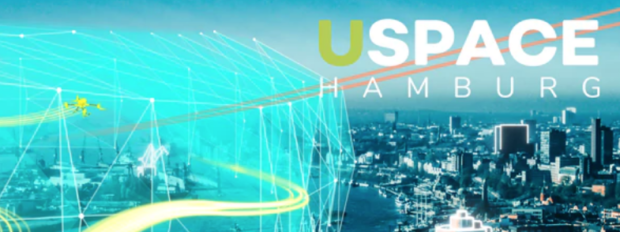and its parent company DFS Deutsche Flugsicherung GmbH recently published their recommendations for action for the establishment of U-Space areas. The findings collected are based on a research project funded by the German Federal Ministry of Digital Affairs and Transport (BMDV). With their help, U-Space areas are to be further advanced in Germany and introduced from 2023.
With U-Space areas, drones can be safely integrated into the airspace – also in interaction with manned aviation. This enables regular use of drones, for example in logistics, agriculture, for supplying hard-to-reach areas or transporting vital medical equipment. How U-Space areas can function in practice was tested in real operation in the U-Space real laboratory, which Droniq and DFS set up in the Port of Hamburg. The research project, which lasted seven months, had a volume of approximately one million euros and was funded by the Federal Ministry of Digital Affairs and Transport (BMDV) with almost 500,000 euros.
Volker Wissing, Federal Minister for Digital Affairs and Transport:
“With around 400 companies, Germany is the lead market for drone technologies. We want to strengthen and further expand this technological lead of Germany. The U-Space Reallabor has answered many important questions for us for the establishment of U-Space areas. We are now using this successful practical experience to enable progress. The first U-Space areas are to be established in Germany as early as next year. In this way, we will create safety in German airspace and enable more innovations in unmanned aviation.”
The BMDV is using the findings and recommendations from the practical tests in the Hamburg U-Space Reallabor to develop a concept for the establishment of U-Space areas throughout Germany. The requirements of the European U-Space Regulation (2021/664) will also be taken into account. The concept is intended to create all legal and practical foundations for the implementation of U-Space areas. The BMDV intends to designate the first U-Space areas as early as 2023.
Research in this area will also be further advanced, e.g. through the LUV project (solutions and recommendations for action for the national implementation of the U-Space Regulation) funded by the BMDV. The aim is to further expand technological progress in unmanned aviation and to strengthen Germany as an innovative business location in international competition.
On the recommendations for action
The results of the U-Space Reallabor include recommendations and measures for the establishment of U-Space areas, their operation and the design of the roles and services applicable in a U-Space.
First implementation of U-Space areas in model regions
Among the proposals is the recommendation to establish U-Space areas in model regions to gain further experience in their implementation and operation. For this purpose, Droniq and DFS recommend complex airspaces with busy unmanned and manned air traffic, such as large cities with airport connections. This is because a coordinating and regulating framework environment such as U-Space is particularly necessary in these areas. With increasing experience, further U-Space areas can be introduced or existing U-Space areas can be expanded or interlinked. A catalogue of criteria developed by Droniq and DFS will help to assess when and where it makes sense to establish a U-Space area.
Differentiation option for U-Space service providers
Another recommendation concerns the competitive situation in a U-Space area. In this area, U-Space Service Providers (USSP) coordinate the drone traffic. In general, there can be several USSPs in a U-Space that compete with each other and differ in service and price.
“For U-Space areas to promote the economic potential of drone operations, there needs to be competition that benefits drone operators,” says Jan-Eric Putze, CEO of Droniq, a leading company in Germany for integrating drones into the airspace. “We look forward to welcoming other market players to U-Space alongside ourselves as USSP.” Another important recommendation from his point of view is to establish U-Space areas also in an airport control zone if needed. “By doing so, we pave the way for new Urban Air Mobility concepts, for example when it comes to flying from the airport to the city via air taxi.”
In order to ensure the efficient networking of all participating agencies in a U-Space area, it is recommended to establish a provider of common information services – the so-called Single Common Information Service Provider – for each U-Space area. On this basis, the operator of U-Space services – the U-Space Service Provider – can make its services available, as was demonstrated in the real laboratory. An integrated air situation picture for all stakeholders is the core for the safe operation of manned and unmanned air traffic.
“The findings from the real lab show that the implementation of the U-Space concept in Germany works, says Angela Kies, Head of Unmanned Aircraft Systems at DFS. “Implementation can now be consistently pursued to efficiently enable the safe use of drones.”
The complete recommendations for action by Droniq and DFS are available for download at www.u-space-hamburg.de.
About the project U-Space Reallabor Hamburg
Last year, Droniq and DFS demonstrated for the first time in Germany how a U-Space can be put into practice in accordance with the requirements of the European Aviation Safety Agency EASA. For this purpose, the companies set up a U-Space reallaboratory in the Port of Hamburg. The role of U-Space Service Provider (USSP) was assumed by Droniq, while DFS acted as Single Common Information Service Provider (SCISP) in the project. The project, which lasted seven months, had a volume of approximately one million euros and was funded by the Federal Ministry of Digital Affairs and Transport (BMDV). The real lab was implemented with several project partners. These included the Hamburg Port Authority AöR (HPA), HHLA Sky GmbH, the Hamburg Ministry of Economics and Innovation, Hamburg Aviation and the project consortium UDVeo.
Image:Fabiano Waewell / EyeEm via Getty Images
Source: Press Release

